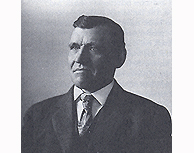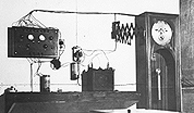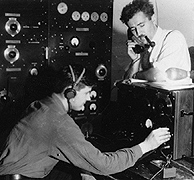Geophysical Institute History "The Beginning" - Part 2

By the late 1930s and early 1940s scientists around the world began to develop theoretical
constructs and equipment to prove or disprove their theories concerning relationships
among Earth's aurora, ionosphere, magnetic field and radio wave propagation.
Some of the different inventions and theoretical constructs developed by scientists
were newly invented radio detection called RADAR, which revolutionized navigation.
Charles Richter formulated a logarithmic scale called the "Richter Scale", to standardize
the assignment of magnitude to earthquakes. Alan Turing, mathematical logician, derived
the theoretical groundwork for computers. Mount (Saint) Augustine in Alaska erupted
and increased theoretical constructs of plate expansion.
In 1935, the Alaska Agricultural College and School of Mines became the University of Alaska and geophysical science did not exponentially grow as expected after the Second International
Polar Year in 1932 (Part 1) and there were only one or two staff members. College Hill was only a scientific
observing station that consisted of operating routine recording instruments, including
a seismograph, for the Department of Terrestrial Magnetism "DTM" and the U.S. Coast
and Geodetic Survey.

In 1936, Regent Martin Harrais had the foresight that the university's unique geographical location would allow
it to be at the forefront of the RADAR and Radio revolution. He wrote a special resolution
the "Harrais Resolution" offering the federal government a site on which to construct
research facilities at College Hill. The resolution had set in motion the eventual
establishment of the Geophysical Institute. President Bunnell presented the resolution to Anthony J. Dimond, Alaska's nonvoting delegate to Congress.
It did not pass in Congress until 1946.
With the United States entering WWII in 1941, the understanding of propagating ionospheric
radio wave transmission became a primary goal of the University of Alaska to help
in the war effort. To reach this goal, Carnegie Institute's John Fleming and President
Bunnell had created a cooperative research facility "College Observatory" that was
funded and operated by the Department of Terrestrial Magnetism "DTM". The newly appointed
supervisor Lloyd Berkner arrived in April 1941 with Stuart L. Seaton (future director
of Geophysical Institute) from DTM to begin the installations. With the help of Ervin
Bramhall and four students, they established the new College Observatory from 1941-1946.

Despite high turnover of faculty, staff, and students from enlisting or volunteering, the College Observatory was able to supply invaluable data on air navigation, geomagnetism, "light of the night sky", radio communications, and seismological observations to Allied Armed Forces in the Pacific Theater. A radio direction finder was also invaluable in locating distant radio transmitters operated by opposing Axis nations. The US Army even used future University President Terris Moore's mountaineering expertise for a cold weather expedition to Denali designed to test clothing and equipment. Moore's trip also contributed to an experiment designed to determine the extent of cosmic ray interference with radio wave propagation.

Sources:
Cole, Terrence. The Cornerstone on College Hill An Illustrated History of the University of Alaska Fairbanks. 1994. University of Alaska Press. Bookcrafters, Inc.
Davis, Neil. The College Hill Chronicles How the University of Alaska Came of Age. 1992. University of Alaska Foundation. Bookcrafters, Inc.
Links:
Geophysical Institute History website here
Keith B. Mather Library for the Geophysical Institute & International Arctic Research website here
